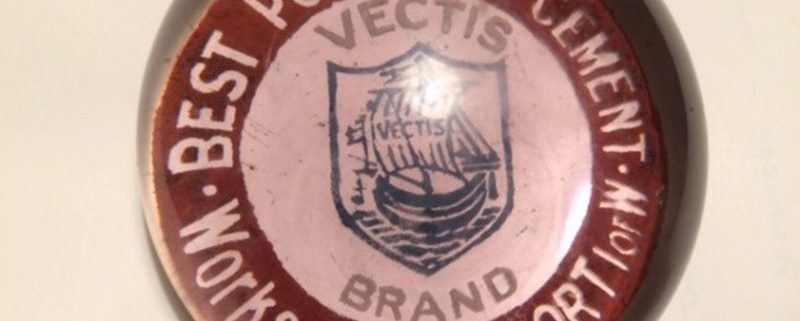
Cement Mill Stories
Paperweight with Vectis brand of Portland Cement ©Dave/Rod Warne
Background
As part of the Dodnor Rediscovered HLF funded project, a group of local volunteers have carried out research in to the social history of the West Medina Mills Cement works at Dodnor, Isle of Wight.
An extremely well researched book on the West Medina Cement Mills was published by Alan Dinnis in 2016 which sets out the development, operation and history of the site and also includes information on his grandfather, James Lovell Warsap, who was manager of the West Medina Mills cement works and a lot of social history including health and accidents, the cricket team and work celebrations. Alan had also researched the 1851 to 1911 censuses and newspaper articles to produce a list of people who worked at the West Medina Cement Mills. The volunteers wanted to add to the information gathered by Alan Dinnis and because they felt that the stories of the lives of the ordinary local Island workers were important ones that needed telling.
The full report can be read here and its well worth a read, but if you are a family historian searching out your long-lost relatives, we have pulled out the list of people we think were associated with the site here. This page is a taster of some of the stories.
People of the Mills
The Warne Family Story
Rod Warne, one of the volunteers on our Dodnor Rediscovered excavations projects, mentioned that he had played on the site as a boy as his father Dave Warne worked at the Cement Depot at West Medina Mills site. Read Rod’s memories and stories of his family’s involvement with the site in the main report.
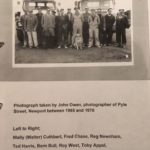

Dave’s cousin, Peter Warne was also a driver at the cement depot. He was known as “Jack” and is shown on the photograph taken between 1965 and 1970 by John Owen of Newport.
An amazing coincidence led to Rod discovering that on his mother’s side he also had ancestors at the site. Edward Cave, his Great, Great Grandfather, was ‘Night foreman and night tester’. The image to the right shows him receiving his long service certificate.
Another family connection was found too. His maternal Grandfather, Maurice Edwin John Prouten, was a steam train driver on the Island between 1947 and 1974 so must have passed by the kilns on the Newport – Cowes line hundreds of times on his engine, Chale 31.
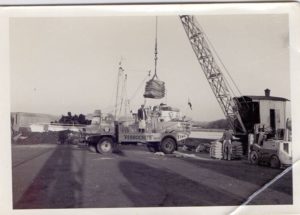
Dave Warne shares his memories of the surviving cement kilns and his time working for the company in the report too. The steam crane was still in use when I worked there and the driver, who was 65 years old when I met him, had driven it all his life. It was eventually sold to Newport Council and was left on the site at St Mary’s. Dave used to deliver 5 loads of concrete every day and was on piece work, so earned a good wage. They were lifted off the boat with the crane and were stacked in 3 rows of 6 plus two on the top, then the men lifted them from the floor into the lorries. That was a hundred-weight of cement all moved by hand from the lorries. When the cement was moved to bulk tanks, it was a lot easier but the bags were made of paper and sometimes split.
The McDine family
John McDine kindly shared a number of photographs of the cement works site, including one similar to the new rotary kiln which are which was installed in 1911.
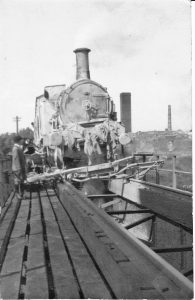
John McDine’s grandfather was Alfred Henry McDine who worked at the West Medina Cement works site for 43 years after joining as an apprentice fitter in 1895. John’s uncle Len McDine who is pictured as a schoolboy onlooker at the result of the 1924 railway crash – Len lived in the nearby Vectis cottages and was returning home.
The 1924 railway accident on the viaduct over the mill pond with Len McDine in his school uniform.
The Chase Family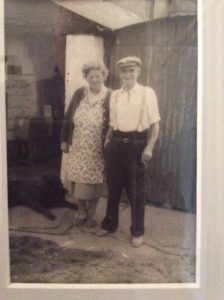
Frederick Henry Chase (b. 1902 d. 1974) was married to Norah Eileen CHASE nee CUSACK (b 1907 d. 1984) and they lived at 2, Dodnor Cottages, Dodnor Lane, Newport from 1935 to when they died. Frederick worked as a Lorry Driver at the West Medina Cement Mills from 1931 to 1967 until retirement. He served during WW2 in the RAF. Norah worked in the Cement Mills canteen.
Their son, Frederick William Chase (b.1928 d. 2005), upon leaving school at the age of 14 years, briefly worked as an apprentice fitter in the Cement Mills, but the draw of the Sea was fulfilled by him joining the Merchant Navy in 1942, setting off in the MV Ferrocrete from the Mills Wharf, still 14 years of age.
Richard Frederick Chase (b. 1953) is their Grandson, who spent the majority of his childhood from 1961 to 1969 at Dodnor, so recalls many adventurous times; fishing, boating and playing in The Old Kilns and the Cement Mills derelict site. Richard has supplied us with a full history of the family and many glorious photograph’s of the site. These can be viewed by clicking here.
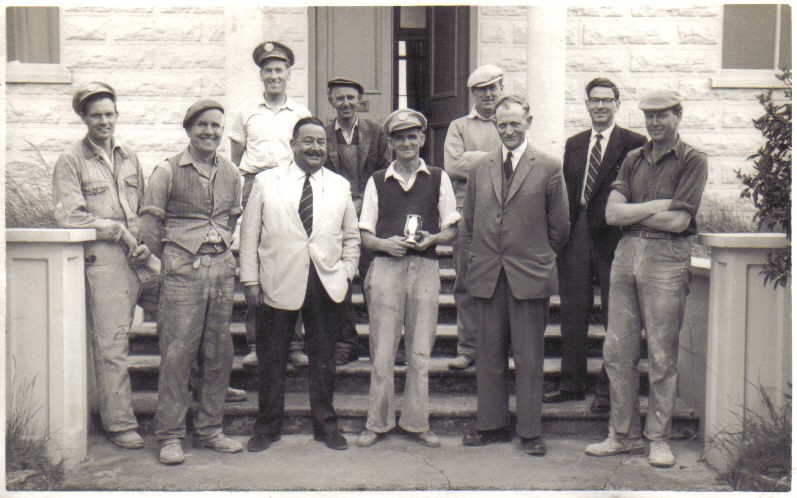
Fred Chase being presented with his safe driving tankard in 1960
The Carter Family
Richard and his cousin Neville Carter came to the site to provide the stories of their grandfather Edwin James Carter, a miller who lived at Horsebridge Hill with his wife Florence and who worked at the West Medina Cement Mills for 53 years from the age of 12 to the age of 65.
Neville’s Father was Edwin Harry Carter, who also worked at the West Medina Mills site for a while as a Cement tester. Because Edwin Harry lived at the rear of the Stag Inn, Neville could see the chimneys on the site from his bedroom window. Both Richard and Neville both used to play on the bogies (carts) in the claypit and were shown how to make a half-penny into a penny on the railway line.
The Prangnells
Henry Stephen Pragnell is mentioned in the 1881 census. By 1886 Henry has left the Cement Mills and was working with a lime kiln on Pan Down when he died in a horrific accident by falling into the lime kiln and asphyxiating on his first day at.
Charles Pragnell was a night watchman who was witness to death of James Marchant in 1894 and again was a witness and night-watchman at an inquest in 1898. Unfortunately the inquest reported by the IW County Press on 10th September 1898 was into the death of Charles Prangnell’s 14 year old daughter Clara Louise Pragnell, who drowned in a boating accident. It’s a tragic story.
Accidents at West Medina Cement Mills and connected sites.
As with most industrial operations, even in the modern day, there are risks for those working there and at allied processes. The West Medina Cement Mills was no exception and the following are examples of some of the incidents related to the Mill, as reported in the local media.
Read, a labourer at the Cement Works, met with an accident on Thursday 19th January 1871 and sustained serious injury to his spine. He was not expected to recover.
In September 1881, a man named James died from lock-jaw, brought about by sinking to his waist in a mass of burning cement in one of the kilns of the Dodnor Cement Mills.
George Prince, a labourer at the Cement Mills, was injured at work on Monday 27th February 1882. While breaking up a boiler he was struck in the eye by a portion of broken-up material, causing a dangerous gash. Medical assistance was summoned at once and it was believed that he would not be prevented from working for long. His son also received an injury to his hand.
Harry Westmore, a labourer at the cement mills, living in Worsley Road, Hunnyhill, had a serious accident on Thursday 26th July 1888 when he slipped and fell into the wash-mill as it was revolving. He clung onto the framework and was carried round several times before he was rescued and taken home seriously injured. Mr. Harry Warsap, who had an ambulance certificate, assisted him and Dr. Wilkins attended Mr. Westmore at home.
On the way home the Queen passed the carriage and was so interested in the case that she sent a messenger from Osborne to the mills the next day to learn how Mr. Westmore was progressing.
In March 1892 a somewhat serious accident occurred whereby a labourer named Lockyer, together with several others, were removing a double plank when the plank dipped out of the rope and fell upon him, giving him severe shock and causing somewhat serious injuries.
In January 1894 an accident killed George Prince at the West Medina Cement Mills. At 69 George was the oldest employee at the mills, having worked there for nearly half a century. T
Before 1894 was out there was another death. James Marchant an engineer on the steam barge Rochester, which belonged to the Cement Mills Company was found floating in a condensing tank.
In October 1895, Benjamin Larkham, a 61 year old labourer at West Medina Cement Mills, was killed as the result of doing a good deed.
In October 1895, a terrible accident occurred in Shide Chalk Pit when one of the labourers, named Walter Hiscock, was bringing loaded trucks down to the siding at Shide, and was on the front buffer of the first truck. As they were going through a narrow passage, Mr Hiscock fell off between the trucks and the side of the passage and was so badly crushed that he died before medical assistance could reach him. A verdict of “Accidental death” was returned.
In April 1896, Charles Baker the 60 year old master of the Smack ‘Mary’ was caught between the quay and the boat. It took 20 minutes for workers at the Mill to get him out, by which time he was dead.
In September 1896 an employee, named Frank Miller, had his right foot rather badly jammed whilst engaged in braking chalk wagons. He was rendered ‘first aid’ and conveyed home in cab by Messrs. H. Warsap and Wheeler, members of the St. John Ambulance, where, “under the treatment of Dr. Thompson, is progressing as favourably as can be expected”.
George Bull, a wheelwright employed at the West Medina Cement Mills, accidentally fell from the side of a building at the works and injured his ribs on 14th February 1906.About a month later he contracted pneumonia and phlebitis and died. His widow Eliza brought a claim under the Workmen’s Compensation Act.
In December 1912, William Albert Hiscock, a labourer, was killed by a blow from a grab attached to a crane which was being used in unloading a ship.
Sidney Ablitt, aged 58, a quarryman at the Shide chalk pit who lived at 23, Drillhall Road, Newport, committed suicide on Monday 9th May 1927, following a series of accidents at the site.
The question that incidents such as the above raise is – who is at fault, if anybody? Has the employer taken enough precautions (in law – so far as is reasonably practicable) and has the employee undertaken their own duty of care to themselves and others. Are these, unfortunately, just pure accidents?
Accidents nearby
It is difficult to know how incidents outside the cement works but inherently related, such as those below, impacted people’s views of the works.
In July 1907 an alarming accident occurred at the level crossing of the Newport and Cowes Railway at Dodnor, near Newport, resulting in the smashing of a motorcar, the occupants of which had a miraculous escape. The train was slowing up to stop at the Cement Mills, or the consequences would have been more serious. In 1925 an island driver was taken to hospital after a cart laden with cement coming over the level crossing at the West Medina Cement Mills was hit by the train from Cowes. The driver of the cart was severely shaken and bruised, and was removed to the hospital, possibly with fractured ribs. The horse escaped. More details on these incidents here.
Accidents involving children
Not only workers were at risk – the site also proved dangerous for children:
In 1845 Julia Dewey, aged 4½, fractured her skull when she accidentally fell through three lofts at Black Mills Cement Factory, Dodnor and died shortly afterwards. An inquest held on Friday 28th November returned a verdict of “accidentally killed”.
On Monday 11th July 1887 a young boy named Ratcliffe nearly drowned while bathing at Dodnor. He was rescued by a friend, Prince who brought him to shore unconscious and might have died but for the efforts of Mr. H. J. Warsap who succeeded in reviving him after an hour’s skilled exertion.
In 1922 a 12-year-old schoolboy, Leslie Joseph Spragg, the son of Mr John Spragg (who lived and worked at West Medina Cement Mills) accidently drowned in a disused reservoir, which was completely open in a field off Stag Lane.
Even after the works shut down they continued to be a source of danger to inquisitive youngsters. In May 1971 it was reported that 3 Newport boys were rescued by a fireman after they became trapped in a cement hopper at the disused Medina Cement Mills. They had apparently climbed to the top of the 40 feet high hopper and slid down the pipes to the bottom. They then found they could not get out. They were rescued by a fireman who was lowered into the hopper by rope. Were you one of these boys? We know your names but have spared you from website embarrassment. Contact us if you want to fess up!
The Good, the Bad and the Ugly
The local newspapers also illustrate some of the behaviour of workers from the West Medina Cement Mills whilst they were outside of working hours. Unfortunately, most newspaper reports, by their nature, focus on the drunken or abusive behaviour.
In May 1867, the Hampshire Advertiser records that George Coster, a labourer at the Cement Works was fined 5 shillings with 5 shillings costs by the Borough Magistrates for an assault on a fellow labourer at the Wagon and Horses pub in Crocker Street.
In 1868 we found three events. William Deffey of “Hunny-hill”, who was a labourer at the Dodnor Cement Works was remanded in custody for alleged wife beating. His wife was unable to attend to give evidence. A week later, on 21st March 1868, the same newspaper reports that the prisoner was discharged on his own recognizance of £10 to keep the peace for 6 months. John Pierce, a labourer emplyed at the Cement Mills was charged with receiving 50lbs of clover seed and 40lbs of flour stolen from East Medina Mill. David Lale, a labourer at the Cement works was summoned before the court to “show cause why he should not be called upon to find sureties of the peace towards his wife Lousia Lale. The newspaper reports that “the parties were considerably advanced in years and the wife was apparently a contentious woman”. Full details are in our report.
In 1870 William Wicker, a labourer at the Cement Works was charged for being drunk and using abusive language towards a police officer at 12.20am in Tontine-yard in South Street. He was fined 5 shillings and had to pay 5 shillings costs with the money to be paid within a week. In 1872 William Hayles, a labourer employed by the Cement Mills was charged with being drunk on Hunnyhill and was fined 5 shillings with 7 shillings and 6 pence costs.
Despite the newspaper reports of the bad behaviour of Cement Mills workers, one employee managed to get into a newspaper report for heroic behaviour. The Hampshire Advertiser of 27th December 1876 reports that two soldiers from the 107th Regiment stationed at Parkhurst carried out a “dastardly attack” on Police Constable Rackett at 11.30 on Thursday night. The soldiers were drunk and the reports says that he would have sustained serious injury if a man named Jeffries, employed at the Cement Mills, had not come to his assistance. The soldiers were committed to hard labour at Winchester for 3 months and it was reported that Mr Jeffreys had “done likewise on several occasions”.
The site was used for initial fire service training at the West Medina Cement Mills site in the 1960’s, and our report lists memories of this. A report in the Isle of Wight county Press October 21st 1967 seems to support the use of the site in the 1960’s by the fire service as it describes an Auxiliary Fire Service Commando Competition at the Cement Mills:
“ About 60 men took part in five-man teams from Newport, East Cowes, Shanklin, Ventnor and Freshwater had to carry items of firefighting equipment over a rugged course and along a ladder laid across a ravine. Teams from Ventnor took first and second places with Shanklin third. The commando trophy was presented to the winning Ventnor team by Station Officer F.J. Hyland.”
Thank you to the many people who helped us compile this page.

